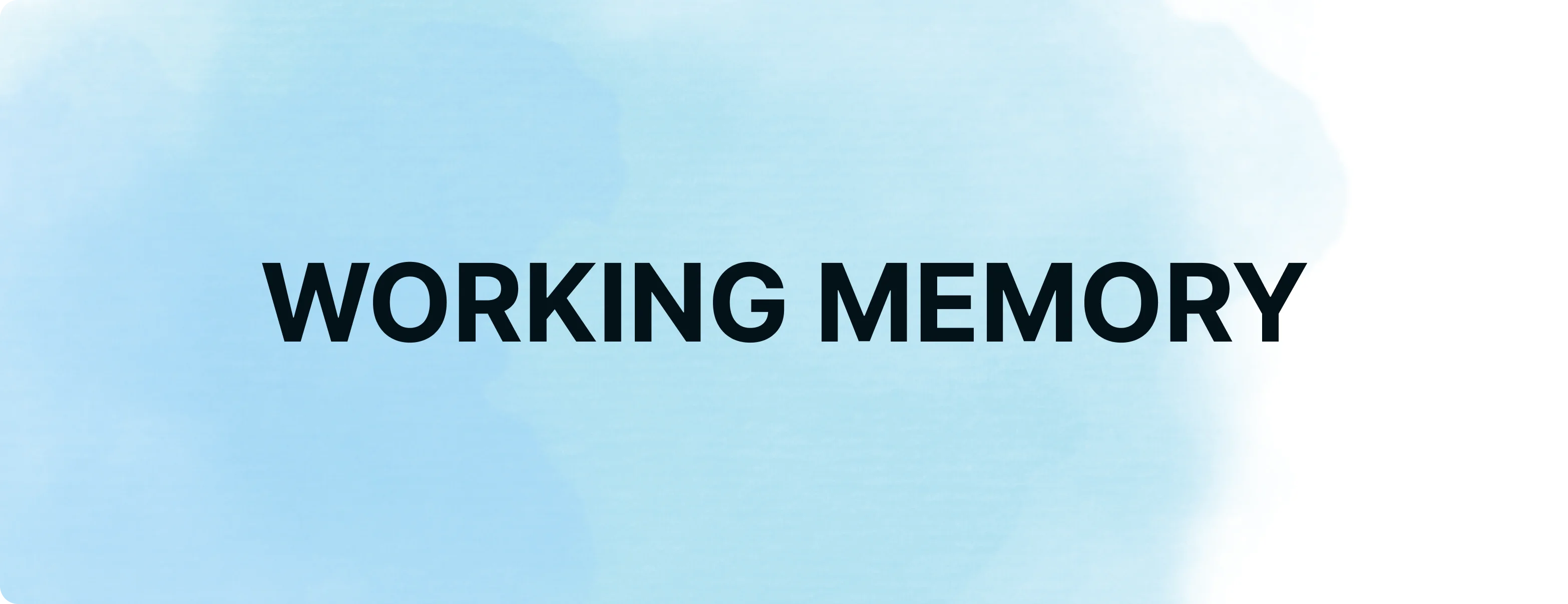Beyond Dyslexia: Working Memory

Chelsea DiMarzio
|
Published on Feb 5, 2024 : 5 min read


Chelsea DiMarzio
|
Published on Feb 5, 2024 : 5 min read

Yesterday, I asked my daughter to go upstairs, brush her teeth, then get her socks and water bottle. She managed to make it up the stairs and back down again with clean teeth, but nothing else. If this sounds familiar, you can blame working memory.
You may have heard the term “working memory” or “short-term memory”, but you may not understand exactly what it is.
Working memory is an often overlooked function of our brains, but it plays a huge role in reading and learning. By the end of this blog, I promise that you will understand working memory in children, and add some new things to your toolbox to support it at home!
So… what is working memory? Basically, it is the brain’s notepad. Working memory is a combination of the brain’s short-term storage and processing systems. Therefore, it is not only short-term memory, but also the actual processing of that information. Short-term memory is responsible for holding information temporarily, but not really doing anything with it. Working memory is more of a “desktop” where information is temporarily stored, sorted, and manipulated for later use.
Some examples of working memory include looking through your refrigerator and pantry before going to the store, and using that information to guide your shopping and remember what items you need to purchase. Another example could be remembering a story or specific details of an event to recount them later.
From the previous examples, you can clearly see that working memory is a major function of our brains. Individuals who have weak working memory skills will likely also struggle with learning.
Some ways that working memory struggles can be noticed in learning include losing your place while reading, forgetting what was just read, struggling to keep your thoughts in order while writing, trouble with multi-step math problems, forgetting directions, appearing distracted, or inability to complete long division or multi-step multiplication problems. Impaired working memory would have implications across subjects as opposed to just one class or skill.
While working memory would affect reading, it is different from Dyslexia. Dyslexia is a language-based learning disability that impairs our brain’s ability to process text and other written figures. While dyslexia can often show up in math through letter reversals and struggles with word problems, it is not a disability that impairs a student’s ability to actually learn and retain information. Dyslexia struggles would present at the word-level, and students may have trouble sounding out words, or blending sounds together. Working memory would be more likely to impair reading comprehension (but not always).
These two learning disabilities can have some similarities, and can also co-exist with each other. When that is the case, it is important to work with an experienced teacher or professional to come up with the most appropriate plan to support a student.
There can be many signs that could indicate a weak working memory. Some of these signs include (but are not limited to):
Assessing working memory is an important part of understanding your child’s learning profile. An experienced licensed school psychologist, educational diagnostician, or private neuropsychologist can complete a psychoeducational evaluation that looks at various cognitive skills, including working memory.
They will administer simple assessments that ask students to complete skills requiring working memory, and they will be able to measure this specific function of our brains in the context of learning. An evaluator may also want to observe a student while they are in the classroom as part of their testing.
This can provide important insight about whether a child is able to stay on task, maintain focus, follow multi-step instructions, and hold and manipulate information in their brain while in a classroom setting. They may also send checklists home with parents, asking you to rate your child’s abilities to accomplish certain skills.
Read More: Does Online Tutoring Work?
Supporting working memory is important for students both at home and in school. Here are some helpful tips for supporting your child who may struggle with working memory:
Working memory is often thought of as short-term memory, but it goes beyond memorizing a phone number just long enough to dial. Working memory is responsible for holding on to information AND being able to manipulate and organize it.
Having a child that with working memory difficulties can feel overwhelming, but once you recognize it, you can start to see your child in a new light.
With small changes at home, the right supports in school, and plenty of encouragement, kids with weak working memory can thrive. Most importantly, remembering to celebrate effort (not just the end result) can help your child build resilience and confidence, one step at a time. Book a free 15-minute call with our learning specialist to get personalized strategies for supporting your child’s working memory.
Looking for personalized support for your child's learning journey?
Our tutoring and dyslexia intervention services are tailored to students with learning differences. Whether it's reading, writing, or other challenges, our team offers one-on-one guidance.
Start with a consultation!Answers to frequently asked questions about IEP support
No. Short-term memory only stores information briefly, while working memory also helps organize and manipulate that information.
Kids may forget steps, lose focus, or struggle with multi-step tasks, not because of laziness, but because their brain can’t juggle too much at once.
Yes. Both can affect learning, but dyslexia is related to reading and language, while working memory impacts processing and task completion.
Yes. With school support, small home strategies, and consistent encouragement, kids can build resilience and thrive.
Break tasks into smaller steps, use visual reminders, celebrate effort (not just results), and seek professional guidance if needed.
Stay updated with our latest blog posts.
Cart